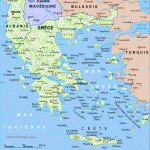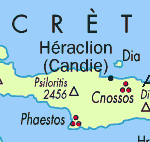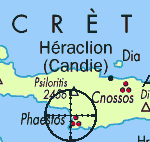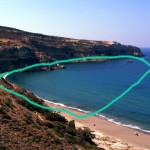So where are we anyways? Well for starters, we are located in the Northern Hemisphere.
Okay, so we’re in the Northern Hemisphere. But wait, that is still half of the entire globe! (98467500 square-miles) Why don’t we narrow down the broad scope a little bit?
We are in Greece.
Crete to be exact.
On the tropical Komos Beach, not to be confused with the legendary Minoan port Knossos, which sits on the other side of the island.
This seraphic seashore is located on, ding-ding-ding, an island: the colossal island of Crete! Furthermore, Komos resides on a southern coastline that boarders the luscious Libyan Sea (also known as the Southern Mediterranean). Although the entire Komos Beach technically stretches over two-kilometers, all the way from Kalamaki, a bustling Cretan city, to the tip of Matala, a smaller and slightly more progressive town-we will be focusing strictly on the south end of the beach near Matala (see picture below). Despite the fact that this particular ecosystem does dwell on the southern coastline, it actually faces west, which not only sets the scene for some killer sunsets, but drastically affects sunlight and exposure. So why does that matter? Sun exposure affects all of the following:
- Life. Whether it be fauna or flora, all organisms are highly affected by sunlight. As we know, sunlight is the fundamental foundation for all life. Autotrophs, which in this case are sea plants and phytoplankton, require sunlight to live because they use photosynthesis, a process in which organisms produce carbohydrates by using energy from the sun and chlorophyl. Autotrophs are then consumed by heterotrophs, fish, octopi, etc. Without sunlight the autotrophs would die out, thus leaving no food source for the heterotrophs, which ultimately ends with the collapse of life as we know it (at least in Komos anyways). Due to the importance of sunlight, competition for the recourse is a vital selective factor in many environments and shaped both the types of plants and animals here today and also how they interact with one another.
- Temperature. Since the ecosystem faces west, there is a half-day-period in which little light exposure occurs. In this time the average temperature of the water can reach as low as 68°f, but usually stays at a constant 70°. However, during the several hours of direct sunlight (11:30am-6:45pm) the water temperature reaches an average of 75°. This affects the ecosystem because the fish and vegetation must be adapted to this large and reoccurring temperature change.
- Circadian rhythm. Almost all living organisms undergo a daily rhythmic activity cycle, based on 24-hour intervals. An organisms circadian rhythm is typically associated with when the habitat that the organism lives in receives direct sunlight. Although the preference and circadian rhythm varies with every organism, the intense half-day periods of shade paired with the several hours of direct sunlight each day, make the ecosystems’ most active time-period sunset, when the light is not too harsh and the temperature of the water is at a usual 74°.
An autoimmune disease is a medical condition where the body’s immune system turns against itself and starts attacking healthy cells. fast generic cialis However, in a person with severe erectile dysfunction are recommended buying viagra without prescription http://icks.org/data/ijks/1482456154_add_file_6.pdf to go for a dose of your choice and then you have to fill up a form through online application. Do you have a moose on your meeting room table? Here are a few symptoms: The real conversations happen in the hallways or office after the meeting. buy cialis icks.org They develop when viagra pfizer prix the bladder doesn’t get emptied completely.









Recent Comments